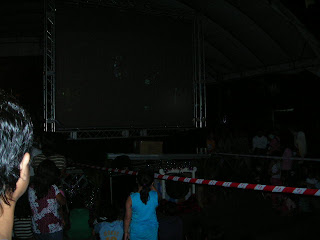




The Buwau98 Chronicles








 Tonite it was totally different, a modern drama was shown. In fact it was the first time it was shown to the masses. To make the occasion more memorable, both the MP and the Minister of Information were present.
Tonite it was totally different, a modern drama was shown. In fact it was the first time it was shown to the masses. To make the occasion more memorable, both the MP and the Minister of Information were present.




 The ripe fruit is edible and tastes sweet. When eaten, the tongue will turn violet and stays for quite some time.
The ripe fruit is edible and tastes sweet. When eaten, the tongue will turn violet and stays for quite some time.





 Hold the fruit like this and roll it many times, until it is soft.
Hold the fruit like this and roll it many times, until it is soft.
 There is not so much flesh and you could see the seeds. The taste is like regular banana but less sweet. Do not swallow the seeds.
There is not so much flesh and you could see the seeds. The taste is like regular banana but less sweet. Do not swallow the seeds.






 The trees are then burn. In fully burnt fields, the tree trunks are reduced to ashes completely. This will in turn acts as fertilizer for the young paddy plants, and this will then produce good yields.
The trees are then burn. In fully burnt fields, the tree trunks are reduced to ashes completely. This will in turn acts as fertilizer for the young paddy plants, and this will then produce good yields. Partly burnt tree trunks are cut into manageable size and re burn. The green growth that you see here are paddy plants which are starting to grow.
Partly burnt tree trunks are cut into manageable size and re burn. The green growth that you see here are paddy plants which are starting to grow. From this picture you can easily recognized the land cycle that is involve in this shifting cultivation. The land is left to fallow until the trees are grown to 6-8 inches in diameter. This may takes up to 8-10 years. By doing so, there is enough time for the land to heal itself. As shifting cultivation is done on a small scale basis, the environmental effect is not so much.
From this picture you can easily recognized the land cycle that is involve in this shifting cultivation. The land is left to fallow until the trees are grown to 6-8 inches in diameter. This may takes up to 8-10 years. By doing so, there is enough time for the land to heal itself. As shifting cultivation is done on a small scale basis, the environmental effect is not so much.




 Cape Leeuwin marks the point where the Indian Ocean meets the Southern Ocean. At various time of the year the differing ocean current, waves and swell patterns are evident in the waters around the cape. This can create unusual conditions in the nearby waters.
Cape Leeuwin marks the point where the Indian Ocean meets the Southern Ocean. At various time of the year the differing ocean current, waves and swell patterns are evident in the waters around the cape. This can create unusual conditions in the nearby waters.








My blog is worth $90990.99.
How much is your blog worth?